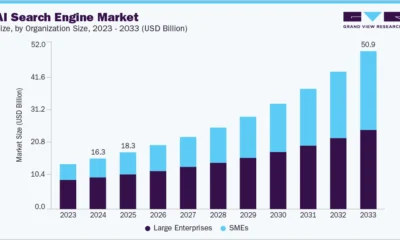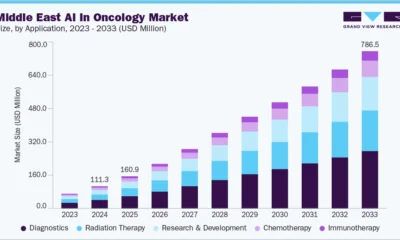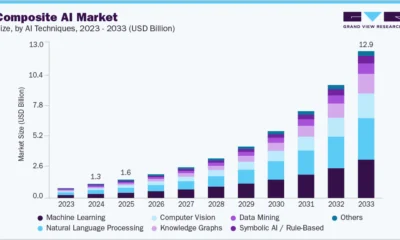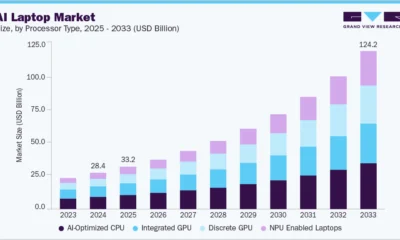AI Research
Generative AI In Chemical Market Size
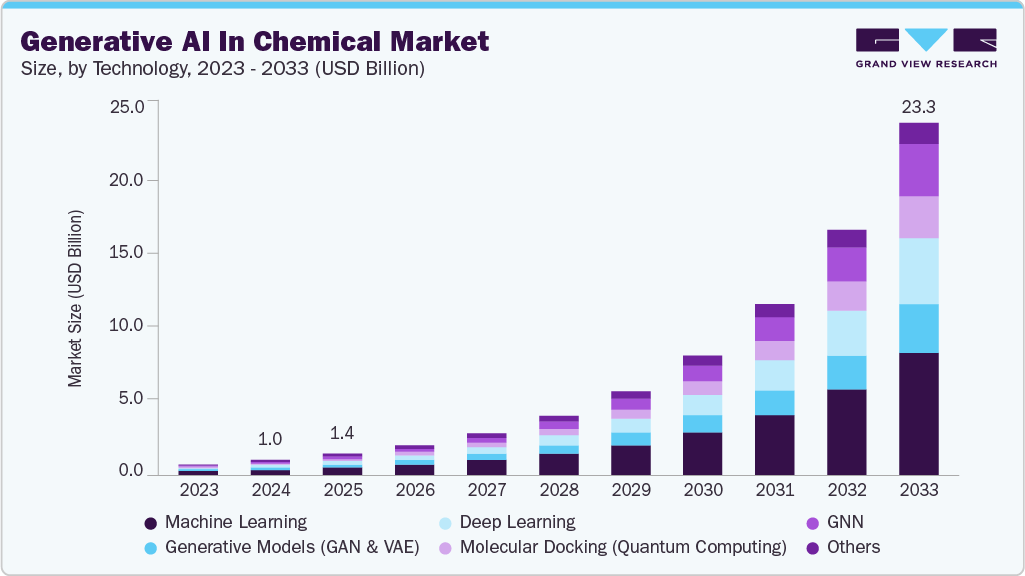
Generative AI in Chemical Market Summary
The global generative AI in chemical market size was estimated at USD 1,019.7 million in 2024 and is projected to reach USD 23,346.1 million by 2033, growing at a CAGR of 41.9% from 2025 to 2033. Generative AI (GenAI) is fueling growth in the chemicals and materials sector by enhancing the speed and efficiency of research and development, using advanced machine learning and data analytics.
Key Market Trends & Insights
- North America dominated the global generative AI in chemical market with the largest revenue share of 36.6% in 2024.
- The generative AI in chemical market in the U.S. led the North America region and held the largest revenue share in 2024.
- By technology, the machine learning segment led the market, holding the largest revenue share of 37.7% in 2024.
- By application, the molecular design & drug discovery segment held the dominant position in the market and accounted for the leading revenue share of 40.3% in 2024.
- By application, the reaction prediction & retrosynthesis segment is expected to grow at the fastest CAGR of 46.5% from 2025 to 2033.
Market Size & Forecast
- 2024 Market Size: USD 1,019.7 Million
- 2033 Projected Market Size: USD 23,346.1 Million
- CAGR (2025-2033): 41.9%
- North America: Largest market in 2024
It accelerates the discovery of new materials, resulting in faster development cycles and lower costs. This technology allows for the swift identification of optimal material formulations, boosting both product performance and sustainability. The rapid progress enabled by GenAI is vital for driving innovation and maintaining a competitive advantage in a rapidly changing chemical market. The expansion of generative AI in chemicals is primarily driven by its power to improve quickly through advanced molecular design and the discovery of new compounds. It is majorly used for accurately predicting molecular structures with specific properties, it reduces dependency on expensive and time-sensitive trial and error methods, allowing for more efficient product development. All these drivers help new chemicals, pharmaceuticals, and materials in reaching the market faster, which is an essential advantage for maintaining competitiveness.
Generative AI in chemical industry is driven by the process optimization in chemical manufacturing by simulating chemical reactions, GenAI helps determine the best parameters to boost energy efficiency, maximize yield, and minimize waste. This supports the industry’s growing focus on sustainability and cost-efficiency, enabling the production of higher-value outputs with less environmental impact. Moreover, AI-powered predictive maintenance reduces equipment downtime and operational costs by anticipating failures and allowing for timely, proactive maintenance.
Furthermore, the increasing quantity of chemical data combined with advancements in machine learning algorithms is a significant factor driving the adoption of generative AI in chemical industry. The richness of data within the chemical industry allows for the development of advanced models that focus in creating safer, more sustainable chemicals and improving manufacturing efficiency and innovation. In addition, the rising pressure to adopt environmentally friendly practices and meet regulatory standards is encouraging chemical companies to invest in GenAI solutions to support their sustainability objectives.
Technology Insights
The machine learning segment led the market in 2024, accounting for a 37.7% of global revenue driven by its capability of enabling efficient navigation of complex chemical search spaces that traditional methods find challenging. ML algorithms process large volumes of data to detect complex patterns and correlations between molecular structures and their properties, supporting in the creation of new molecules with specific attributes. This predictive, data-driven approach speeds up the discovery and refinement of chemicals, catalysts, and materials while minimizing time and resource use. Moreover, ML enhances predictive maintenance, process efficiency, and safety in chemical manufacturing, promoting sustainable and environmentally friendly practices. For instance, in December 2023, Merck introduced AIDDISON, the first AI-powered platform that merges generative AI with machine learning to transform drug discovery and synthesis. It accurately predicts essential drug properties, enabling highly precise molecule design through the integration of AI-driven molecule creation and retrosynthetic analysis, it drastically minimizing development time and expenses. This innovative technology marks a major advancement toward faster, safer, and more sustainable drug development.
The GNN segment is expected to grow at the fastest CAGR during the forecast period, driven due to advancements in the chemical industry by effectively modeling the complex, non-linear relationships within molecular structures, where atoms and bonds are represented as graph nodes and edges. Unlike traditional machine learning models that depend on manually engineered features or simplified linear formats, GNNs learn directly from chemical graphs, capturing both structural complexity and multi-dimensional details. Their architecture enables the encoding of both 2D molecular connectivity and 3D dimensional configurations, majorly for predicting chemical properties, reactivity, and designing new molecules. GNNs support the generation of molecules optimized for specific chemical or biological traits, significantly speeding up drug discovery and material development. Their ability to learn rich representations and explore extensive chemical spaces efficiently is fueling widespread adoption and ongoing research in generative AI within the chemical sciences.
Application Insights
The molecular design & drug discovery segment accounted for the largest market revenue share in 2024, driven by enabling the rapid creation of novel chemical compounds with favorable beneficial and physicochemical properties. A major driver behind this shift is the high cost and lengthy timelines associated with traditional drug development, which generative AI aims to reduce faster, in silico exploration of expansive chemical space. The technology supports precise de novo molecule design, expanding chemical libraries, and identifying compounds that are both drug-like and synthetically feasible. The technology used in molecular design & drug discovery is continuously enhanced by rich chemical datasets and improved molecular representations such as SMILES, and 2D/3D graphs and also deep learning models such as RNNs, VAEs, GANs, and GNNs can effectively predict, generate, and refine new molecules. This accelerates early-stage lead discovery, lowers experimental demands, and increases the chances of developing safe, effective, and innovative drugs. For instance, in April 2025, Mount Sinai established a drug discovery center for AI small molecules to transform the drug development process by combining advanced AI technologies with conventional approaches. The center utilizes generative AI to create innovative drug-like molecules, enhance compounds for improved safety and effectiveness, and forecast drug-target interactions to advance drug repurposing. The goal of this initiative is to speed up the development of new remedies for critical unmatched medical needs, including cancer, metabolic disorders, and neurodegenerative diseases.
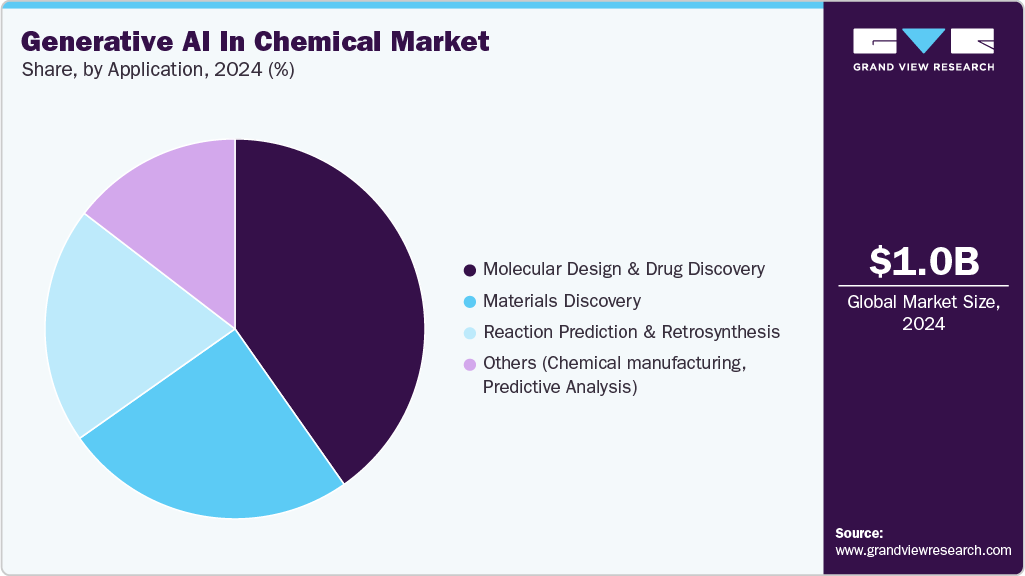
The reaction prediction & retrosynthesis segment is expected to grow at the highest CAGR over the forecast period, driven by its ability to speed up chemical discovery and design. By using large datasets of known reactions, AI can accurately predict reactant-product outcomes and synthesis routes, minimizing the need for traditional trial-and-error methods. In addition, these models enhance the optimization of reaction conditions such as temperature and catalysts, leading to improved efficiency and selectivity. Generative AI also enables the automated generation of multiple synthesis pathways for target compounds, helping chemists prioritize and explore alternatives. By incorporating both local and global molecular reactivity data, these tools achieve high accuracy and adaptability across various chemistries. Ultimately, they play a crucial role in reducing research costs and timelines, particularly in drug development and materials science, while promoting more sustainable and targeted innovations. For instance, in March 2024, Elsevier partnered with Iktos to combine advanced AI technology with the comprehensive Reaxys chemistry database, creating a next-generation synthetic chemistry platform. This partnership boosts predictive retrosynthesis and synthetic accessibility capabilities, streamlining the drug discovery process by enabling quicker identification of preclinical applicants. Their AI-powered tools offer advanced analytics through a natural interface and APIs, providing valuable support to pharmaceutical researchers.
Regional Insights
North America generative AI in chemical industry dominated globally with a revenue share of 36.6% in 2024, driven by the region’s strong technological foundation, early AI adoption, and its dynamic innovation ecosystem, characterized by close collaboration among top tech companies, innovative research institutions, and major players in the chemical industry, also significant funding for AI startups, along with supportive government policies and clear regulations, accelerates adoption. The demand for quicker, more cost-efficient drug and material discovery, along with early implementation by pharmaceutical and specialty chemical sectors, is fueling the use of generative AI to boost productivity, meet regulatory standards, and advance sustainability goals.
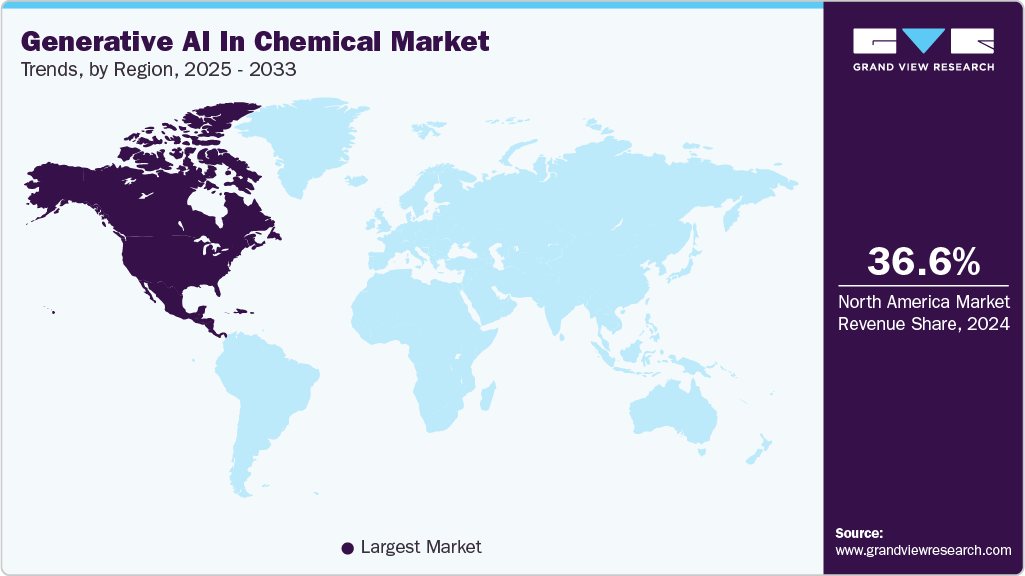
U.S. Generative AI In Chemical Market Trends
The U.S. generative AI in chemical industry is expected to grow significantly in 2024, driven by its significant federal funding and private investment in AI research are accelerating its application in areas such as drug discovery, specialty chemicals, and materials science. Early adoption of AI by key players in these industries enhances productivity and speeds up the discovery of new molecules. Furthermore, the presence of advanced cloud infrastructure and well-defined regulatory guidelines enables rapid deployment and scaling of AI solutions. Efforts to improve sustainability and reduce costs also contribute to the growing use of generative AI for more efficient and environmentally friendly chemical processes.
Europe Generative AI In Chemical Market Trends
The Europe generative AI in chemical industry is witnessing steady growth over the forecast period,is driven by its strong focus on sustainability, green chemistry, and rigorous regulatory requirements. Major companies are using AI to create environmentally friendly materials, reduce ecological impact, and comply with strict EU regulations. Strong public and private research investments, along with EU-supported AI initiatives, strengthen this drive. In addition, Europe’s dedication to circular economy practices such as converting waste into valuable chemicals, this positions the region at the forefront of industrial innovation and environmental responsibility through AI.
Asia Pacific Generative AI In Chemical Market Trends
The generative AI in chemical industry in the Asia Pacific region is anticipated to register the highest CAGR over the forecast period is fueled by its extensive chemical manufacturing base, strong government backing for digital transformation, and significant investment in AI research. Nations such as China, India, Japan, and South Korea are using generative AI to enhance scalable production, develop advanced materials, and strengthen their competitive edge in the pharmaceutical and chemical industries. The region’s growing demand for efficient and innovative chemical solutions, alongside a quickly advancing digital infrastructure, positions it as the fastest-growing market in this field.
Key Generative AI In Chemical Company Insights
Some key companies in the generative AI in chemical industry are Accenture, HELM AG, Omya AG, and Google.
-
Accenture is connecting generative AI to revolutionize the chemical industry by accelerating innovation in research and development. Their AI tools help chemical companies streamline complex data analysis, predict chemical properties, and suggest experimental approaches for new formulations, greatly enhancing R&D efficiency. Through its AI Refinery platform, company enables the rapid creation and deployment of customized AI agent networks, reducing development timelines from months to days. By integrating advanced AI with cloud and digital technologies, the company supports sustainability, productivity, and operational excellence across the chemical value chain. Accenture’s goal is to help chemical firms reimagine innovation, optimize processes, and drive growth while navigating regulatory and environmental demands.
-
Omya produces industrial minerals mainly calcium carbonate and dolomite-based fillers and pigments and distributes specialty chemicals worldwide. Serving a broad range of industries, including construction, paper, polymers, food, personal and home care, agriculture, water, and energy. The company focuses on innovation and sustainability by offering efficient, eco-friendly solutions that boost customer productivity and competitiveness. The company combines deep expertise in mineral and chemical engineering, and this strong foundation positions Omya to effectively adopt generative AI in the chemical sector, driving optimized formulations, sustainable innovation, and improved process efficiency.
Key Generative AI In Chemical Companies:
The following are the leading companies in the generative AI in chemical market. These companies collectively hold the largest market share and dictate industry trends.
- Accenture
- AION Labs
- ChemAI Ltd
- HELM AG
- IBM Corporation
- Microsoft
- Mitsui Chemicals, Inc.
- NVIDIA Corporation
- Omya AG
Recent Developments
-
In March 2025, AION Labs collaborated with BioMed X, to establish “Generative AI for Novel Target Combinations.” The goal is to create an AI-powered platform that can identify and validate unique molecular target combinations for multispecific biologic drugs for treating complex diseases such as cancer and metabolic disorders by using advanced computational methods and large-scale biomedical data, the platform aims to transform multi-target drug discovery. Supported by top pharmaceutical and technology partners, the initiative is seeking experts in AI, biomedical science, and computational biology from around the world.
-
In June 2024, Microsoft announced two innovative features within Azure Quantum Elements which is Generative Chemistry and Accelerated DFT, that combine generative AI, high-performance computing, and quantum technologies to revolutionize molecular and material discovery. These capabilities offer intuitive workflows that enable scientists to quickly generate, evaluate, and simulate potential compounds, reducing research timelines from years to just days. Designed to drive rapid innovation, these tools support breakthroughs across chemistry, materials science, and sustainable technology development.
-
In March 2024, NVIDIA introduced more than 20 new generative AI microservices for transforming the healthcare industry. Supplied through the NVIDIA NIM platform, these microservices streamline workflows in areas such as drug discovery, medical imaging, and genomics by providing optimized AI models personalized for biology, chemistry, and digital health. Pharmaceutical and biotech companies are already adopting these tools to improve molecular design and enhance patient care.
Generative AI In Chemical Market Report Scope
|
Report Attribute
|
Details
|
|
Market size value in 2025
|
USD 1,422.4 million
|
|
Revenue forecast in 2033
|
USD 23,346.1 million
|
|
Growth rate
|
CAGR of 41.9% from 2025 to 2033
|
|
Base year for estimation
|
2024
|
|
Actual data
|
2021 – 2024
|
|
Forecast period
|
2025 – 2033
|
|
Quantitative units
|
Market revenue in USD Million & CAGR from 2025 to 2033
|
|
Report coverage
|
Revenue forecast, company ranking, competitive landscape, growth factors, and trends
|
|
Segments covered
|
Technology, application, and region
|
|
Regional scope
|
North America; Europe; Asia Pacific; Latin America; MEA
|
|
Country scope
|
U.S.; Canada; UK; Germany; France; China; India; Japan; South Korea; Australia; Brazil; Mexico; KSA; UAE; South Africa
|
|
Key companies profiled
|
Accenture; AION Labs; ChemAI Ltd; Google; HELM AG; IBM Corporation; Microsoft; Mitsui Chemicals, Inc.; NVIDIA Corporation; Omya AG
|
|
Customization scope
|
Free report customization (equivalent up to 8 analysts working days) with purchase. Addition or alteration to country, regional, and segment scope.
|
|
Pricing and purchase options
|
Avail customized purchase options to meet your exact research needs. Explore purchase options
|
Global Generative AI In Chemical Market Report Segmentation
This report forecasts revenue growth on global, regional, and country levels and provides an analysis of the industry trends in each of the sub-segments from 2021 to 2033. For this study, Grand View Research has segmented the global generative AI in chemical market report based on technology, application, and region.
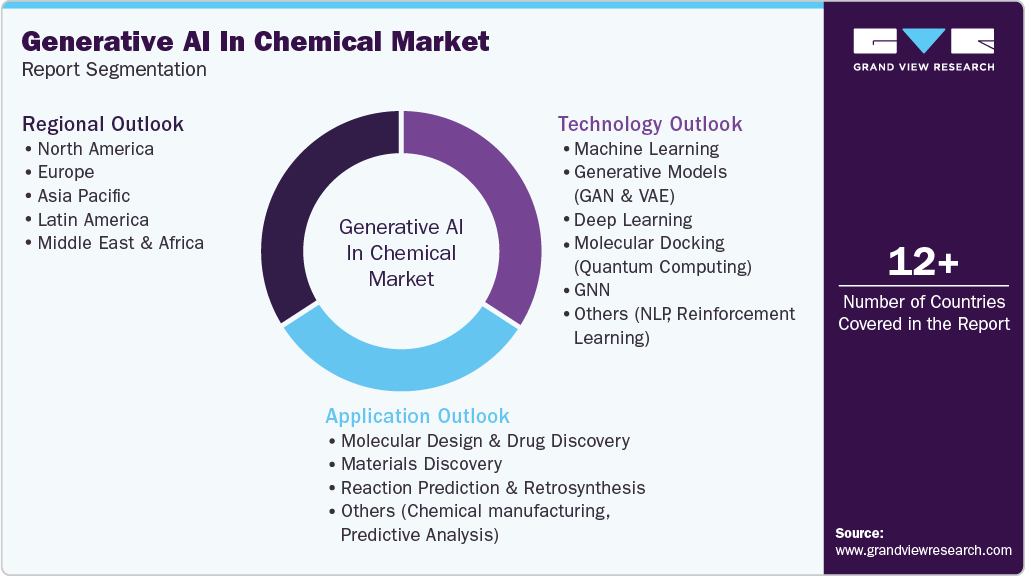
-
Technology Outlook (Revenue, USD Million, 2021 – 2033)
-
Machine Learning
-
Generative Models (GAN & VAE)
-
Deep Learning
-
Molecular Docking (Quantum Computing)
-
GNN
-
Others (NLP, Reinforcement Learning)
-
-
Application Outlook (Revenue, USD Million, 2021 – 2033)
-
Molecular Design & Drug Discovery
-
Materials Discovery
-
Reaction Prediction & Retrosynthesis
-
Others (Chemical manufacturing, Predictive Analysis)
-
-
Regional Outlook (Revenue, USD Million, 2021 – 2033)
-
North America
-
Europe
-
Asia Pacific
-
China
-
India
-
Japan
-
South Korea
-
Australia
-
-
Latin America
-
Middle East and Africa
-
AI Research
FactSet Research Systems (FDS) Integrates MarketAxess AI-Powered Data Into Workstation
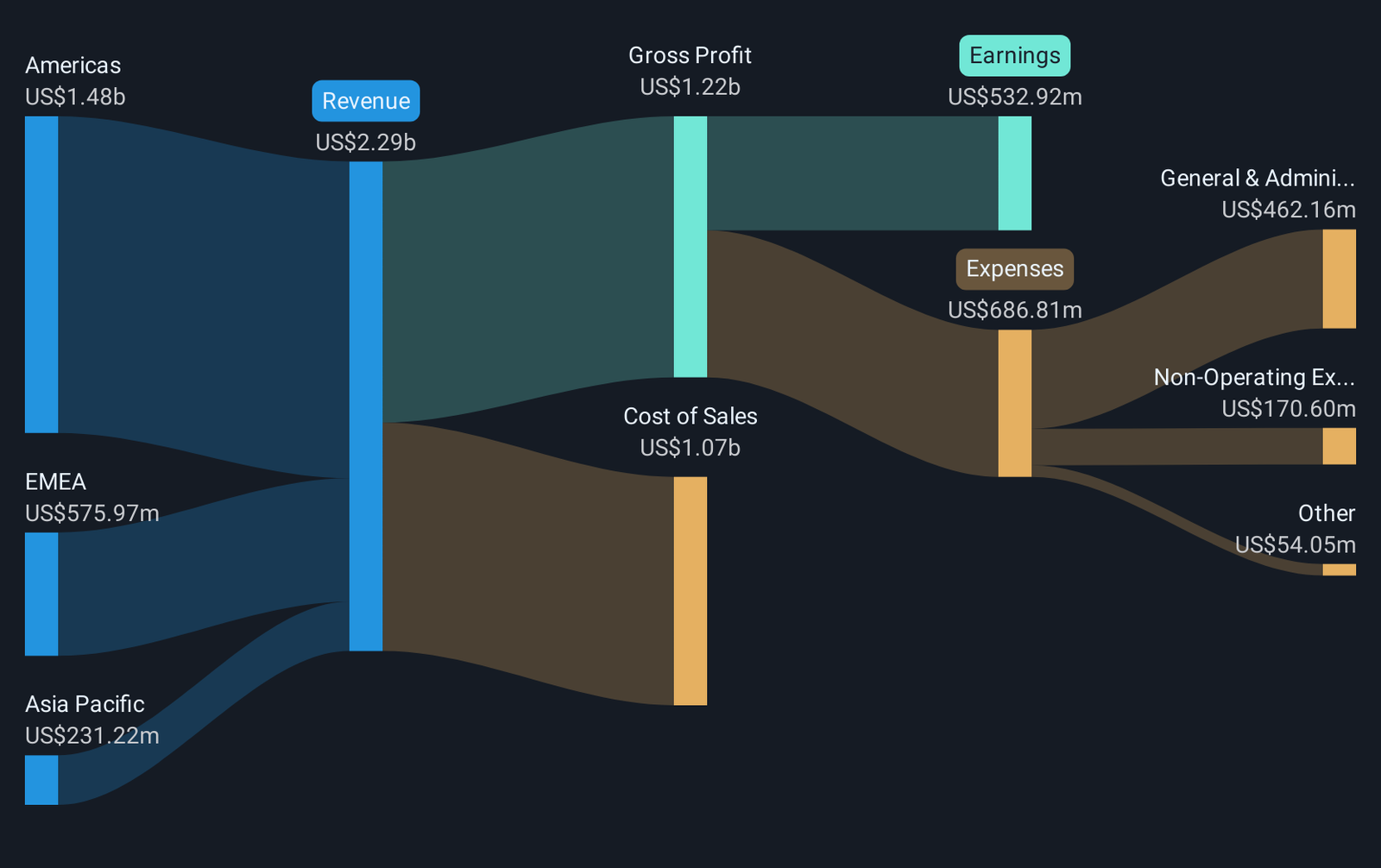
FactSet Research Systems (FDS) has recently integrated MarketAxess’ AI-powered CP+ data into its workstation, making it the sole provider of such capabilities in a terminal desktop environment. This integration is designed to provide users with real-time bond pricing and insights on a vast array of securities, centralizing financial data and enhancing trade execution. Over the past week, FDS saw a 1.08% price increase, aligning with broader market trends as the S&P 500 and Nasdaq reached record highs. FactSet’s addition of cutting-edge features may have added positive weight to its recent price movement amid a generally robust technology sector.
You should learn about the 1 warning sign we’ve spotted with FactSet Research Systems.
The integration of MarketAxess’ AI-powered CP+ data into FactSet’s workstation could significantly enhance the company’s appeal by providing advanced data analytics to its users. This move aligns with FactSet’s strategy of expanding its service offerings through acquisitions and new product launches, potentially boosting revenue and earnings in the future. As FactSet continues to integrate acquisitions and enhance its product lineup, these innovations could strengthen the firm’s position in the competitive financial services market. The recent 1.08% share price increase may partly reflect investor optimism about these enhancements and their potential to drive growth.
Over the last five years, FactSet’s total return, including share price and dividends, was 16.06%. However, the company’s recent performance over the past year fell short of both the broader US market, which achieved a 20.5% return, and the Capital Markets industry, which returned 34.2%. This underperformance could highlight investor concerns regarding rising technology costs and potential challenges in the asset management sector.
The current share price of US$372.86 remains at a discount compared to the consensus analyst price target of US$428.38, suggesting additional upside potential if the company can successfully execute its growth strategies. With revenue forecasted to grow at 5.4% annually, analysts project earnings to rise to US$725.4 million by 2028. To align with these projections, FactSet’s strategic moves in technology and acquisitions will be crucial in achieving the expected revenue and earnings growth.
This article by Simply Wall St is general in nature. We provide commentary based on historical data
and analyst forecasts only using an unbiased methodology and our articles are not intended to be financial advice. It does not constitute a recommendation to buy or sell any stock, and does not take account of your objectives, or your
financial situation. We aim to bring you long-term focused analysis driven by fundamental data.
Note that our analysis may not factor in the latest price-sensitive company announcements or qualitative material.
Simply Wall St has no position in any stocks mentioned.
New: AI Stock Screener & Alerts
Our new AI Stock Screener scans the market every day to uncover opportunities.
• Dividend Powerhouses (3%+ Yield)
• Undervalued Small Caps with Insider Buying
• High growth Tech and AI Companies
Or build your own from over 50 metrics.
Have feedback on this article? Concerned about the content? Get in touch with us directly. Alternatively, email editorial-team@simplywallst.com
AI Research
Researcher Kelly Merrill, Jr. speaks to risks of AI as mental health support

Merrill, who studies the intersection of technology and health communication, was interviewed by Spectrum News to discuss safeguards over AI and health communications.
The interview points out that while Ohio no laws regulating AI in mental health, several states have already acted: Illinois bans AI from being marketed as therapy without licensed oversight, Nevada prohibits AI from presenting itself as a provider, and Utah requires AI chatbots to disclose their nonhuman nature and protect user data.
Merrill urges Ohio lawmakers to follow suit and “protect people over profit.” The assistant professor of health communication and technology in UC’s School of Communication, Film, and Media Studies has spent more than five years researching how digital tools affect well-being, motivated in part by his father’s death from cancer.
His recent study on AI companions found that while about a third of participants reported feeling happier after using them, Merrill cautions that the tools pose risks—including privacy concerns, unrealistic expectations of human relationships, and even dependency. To address these issues, he stresses the importance of “AI literacy,” so users understand what AI can and cannot do.
Merrill also argues that companies should build in safeguards, such as usage reminders and prompts to seek professional help. He supports temporary bans on AI therapy while research catches up, saying the tools should supplement, not replace, overburdened mental health systems.
Watch the interview and read the story.
Feature photo at top iStock photo: AleksandarGeorgiev.
AI Research
LIGO could observe intermediate-mass black holes using artificial intelligence – Physics World
Copyright © 2025 by IOP Publishing Ltd and individual contributors
-

 Business2 weeks ago
Business2 weeks agoThe Guardian view on Trump and the Fed: independence is no substitute for accountability | Editorial
-
Tools & Platforms4 weeks ago
Building Trust in Military AI Starts with Opening the Black Box – War on the Rocks
-

 Ethics & Policy1 month ago
Ethics & Policy1 month agoSDAIA Supports Saudi Arabia’s Leadership in Shaping Global AI Ethics, Policy, and Research – وكالة الأنباء السعودية
-

 Events & Conferences4 months ago
Events & Conferences4 months agoJourney to 1000 models: Scaling Instagram’s recommendation system
-

 Jobs & Careers2 months ago
Jobs & Careers2 months agoMumbai-based Perplexity Alternative Has 60k+ Users Without Funding
-

 Education2 months ago
Education2 months agoVEX Robotics launches AI-powered classroom robotics system
-

 Podcasts & Talks2 months ago
Podcasts & Talks2 months agoHappy 4th of July! 🎆 Made with Veo 3 in Gemini
-

 Education2 months ago
Education2 months agoMacron says UK and France have duty to tackle illegal migration ‘with humanity, solidarity and firmness’ – UK politics live | Politics
-

 Funding & Business2 months ago
Funding & Business2 months agoKayak and Expedia race to build AI travel agents that turn social posts into itineraries
-

 Podcasts & Talks2 months ago
Podcasts & Talks2 months agoOpenAI 🤝 @teamganassi




